
St Ursula's Church, Berne
Energy News
A Church of the Anglican Communion, welcoming all who seek the Lord Jesus Christ

| St Ursula's Church, Berne
| ||||||||||||||||||
| News | Contacts | Who We Are | Where We Are | Magazine | Pictures | Charities | Rotas | Weddings | Site Map | ||||||||||
This page was set up to keep church members up to date with the latest news on the energy project. The project is now complete, but you may be interested in some of the pitfalls along the way which we encountered - and surmounted!
By way of background, Council agreed in June 2013 to form a committee to look into the energy footprint of the church. After a very thorough survey, the committee highlighted several areas where energy was being wasted or poorly used. These areas included the way the church was heated, the periods during which the hall was heated, hall insulation, the hot water supplies in the hall and the house, the insulation of the chaplain's house, and especially of its walls and roof, and the efficiency of the boiler. The committee consulted experts and gathered initial estimates, especially a GEAK Plus report in September 2015, putting the total cost in the region of Fr250'000. An appeal was launched, and a magnificent donation allowed us to undertake further measurements and get down to detail. The committee produced its final report in April 2016 and presented it to Council (though the definitive version was agreed in September 2016) with detailed recommendations (and a final cost estimate of some Fr400'000). Council set up a project team, led by Hans Goepfert, and including Edi Wildhaber, Rolf Klingler, Hector Davie, Isabelle Wienand and Sue Higson. The team appointed H+K Planungs AG as project manager.
| Our Energy and Sustainability Project is now complete. We thank the GVB Kulturstiftung for their generous grant, and the many others who have made large and small contributions to the success of this project. |

|
The work is nearly finished. There are just a few loose ends to tidy up. A few of the radiators in the upper hall and outer office have a blockage, either through sticking valves or an accumulation of sediment - this will be fixed very soon. The new electric circuits in church, which had to be moved because of the presence of the heating pipes inside the walls, need tidying up - the unsightly wires around the monitor in the sanctuary will disappear, and an electric motor installed to position the screen for the projector.
The scaffolding is still there round the chaplain's house because the Denkmalschutz has not yet given its final blessing to the shade of off-white we have used. But in general, it's looking good, and we are thankful for the skill of the workmen, the generosity of the donors, the forbearance of all who have been inconvenienced, and the considerable help from Hans Goepfert, Edi Wildhaber, Rolf Klingler and the energy team, without whom the project would have taken significantly longer and would have cost significantly more. Praise the Lord!
Back in church at last - alleluia!
The final race against time during the last week needed precise coordination. The carpenter had to install the wooden panelling. The plasterer had to make the walls good. Then there was the task of painting and cleaning. All this in the space of a single week - and more besides.
Our first service in the resurrected building was an occasion for joy. Not everything was ready - the projector still has to be commissioned, and the sound system had a few teething troubles, but thanks to our builders, and to our own volunteers, especially to Hans Goepfert, assisted by Edi Wildhaber and Rolf Klingler, everything is either finished or nearly finished!
There is still more work needed on the house, which is still swathed in scaffolding. But this should soon be finished, and from the energy-saving point of view, the work is complete. Alleluia indeed!
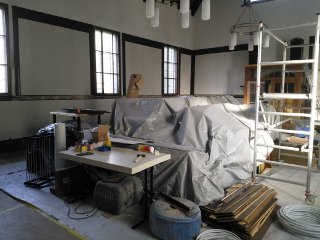
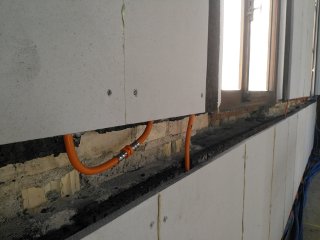 Work on the heating panels is proceeding well.
The panels have been mounted and plumbed together.
As can be seen, the panels take up as little space as possible, and are in two positions, with one row at the bottom of the wall and the other higher up.
This is all dusty work, and in the meanwhile, the organ and many of the church furnishings have been placed in the centre of the nave for protection.
Work on the heating panels is proceeding well.
The panels have been mounted and plumbed together.
As can be seen, the panels take up as little space as possible, and are in two positions, with one row at the bottom of the wall and the other higher up.
This is all dusty work, and in the meanwhile, the organ and many of the church furnishings have been placed in the centre of the nave for protection.
Further work has to be done in the cellar rooms under the church, and Hans, Edi, Rolf and Jana, among others, have worked wonders in clearing this space, which is normally used for storage, so that the workmen can fit the necessary pipework and control equipment.
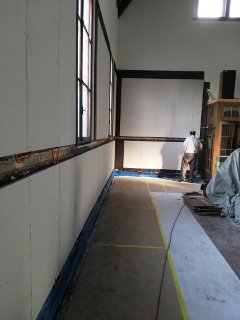 The new heating panels will radiate heat towards the centre of church, and at the same time remove the cooling effect of the outside walls.
They should generate a warm church without any extra source of heat, using a minimum of energy.
The new heating panels will radiate heat towards the centre of church, and at the same time remove the cooling effect of the outside walls.
They should generate a warm church without any extra source of heat, using a minimum of energy.
We have also been putting the hall heating system under the magnifying glass. Instead of being constantly heated, 24/7, the halls, like the church, will only be heated when they are in used. To enable this to be done without difficulty, the supply to the radiators in the two halls and the church will be controlled directly from the church administration calendar, which Jana prepares for booking purposes. This should ensure that a properly booked space is also a warm space!
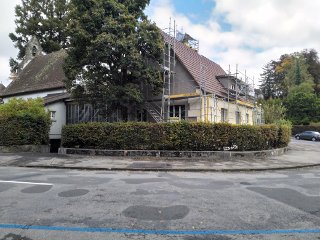 Work is also continuing on the external walls of Stephen's house, slightly delayed by the right insulation tiles not all arriving in time.
As the picture shows, this work is nearly complete.
The next phase will be the external rendering, followed by painting.
The project team spent some time selecting a colour acceptable to the conservation authority (Denkmalschutz). who wanted it to be as near the previous off-white as possible.
Work is also continuing on the external walls of Stephen's house, slightly delayed by the right insulation tiles not all arriving in time.
As the picture shows, this work is nearly complete.
The next phase will be the external rendering, followed by painting.
The project team spent some time selecting a colour acceptable to the conservation authority (Denkmalschutz). who wanted it to be as near the previous off-white as possible.
You may notice that there is extra scaffolding around the chimney. This is because the current building regulations require the flue from the gas boiler to be carried to a point substantially higher than the ridge of the roof. (If you look at pictures of the church from the last century in our "Scenes from the Past" album, you willsee that it too had a chimney, but only to roof ridge level!)
The Church council has discussed when we can return to the church after holding services in the hall. The building work should be complete by the end of the month - potentially a week or more earlier. But to be on the safe side, and to ensure that everything is working properly, we have taken the decision to celebrate with a special service on 5 November, to which donors and helpers will also be invited.
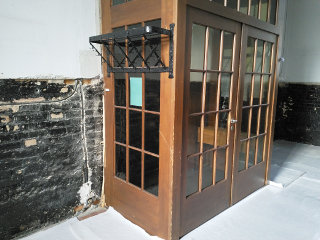
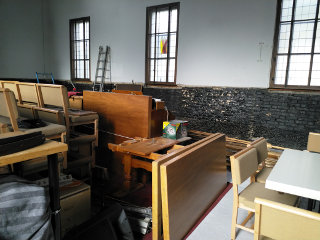 Thanks to our own volunteers, especially Edi Wildhaber, the wooden panelling from the inside of the main part of the church was removed last week.
This revealed the bitumen and bare brickwork beneath it.
The panelling looked good, but the wood was not worth retaining.
(The panelling in the sanctuary, where the walls are internal ones, had stayed as it was.)
Thanks to our own volunteers, especially Edi Wildhaber, the wooden panelling from the inside of the main part of the church was removed last week.
This revealed the bitumen and bare brickwork beneath it.
The panelling looked good, but the wood was not worth retaining.
(The panelling in the sanctuary, where the walls are internal ones, had stayed as it was.)
The builders will be installing thick radiators on the walls here, which will radiate heat out into the church - a technique which has proved effective elsewhere (the parish church in Zollikofen, for instance). After the radiators have been installed, a few weeks on from now, we shall be re-installing panelling similar to what was there before.
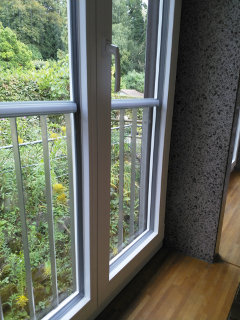 Another work efficiently carried out during the past week has been the installation of sealed, triple-glazed windows in the hall.
The large poorly-insulated window area we had before was a major cause of heat loss, and these will allow us to make big savings.
In the next few days, the hall heating system will be re-commissioned and connected to the new gas boiler.
Another work efficiently carried out during the past week has been the installation of sealed, triple-glazed windows in the hall.
The large poorly-insulated window area we had before was a major cause of heat loss, and these will allow us to make big savings.
In the next few days, the hall heating system will be re-commissioned and connected to the new gas boiler.
Part of the new heating concept for the hall is the regulation of heating times according to the church calendar, meaning that the halls are heated only for times when they are in use. Previously we had heated them 24/7, which was a great waste of energy. The new system means that whenever Jana confirms a hall booking and enters it on the computerized calendar, the heating programme will take note and ensure that the heating is turned on in that part of the hall for the relevant time and date.
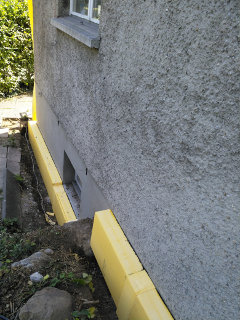 Work has also started on insulating the outside walls of the chaplain's house.
Insulation work inside is nearly complete, with effective insulation being laid in the attic and other parts of the roof space where the floor does not meet the eaves, as well as on the ceiling of the cellar.
Work has also started on insulating the outside walls of the chaplain's house.
Insulation work inside is nearly complete, with effective insulation being laid in the attic and other parts of the roof space where the floor does not meet the eaves, as well as on the ceiling of the cellar.
The wall insulation will extend up the whole height of the wall, and after what, new windows will be installed. (The window sills will also have to be renewed, to take account of the thicker walls.)
With all this work going on, there is a real feeling that things are under way. Hans Goepfert is doing a masterly job of supervising and co-ordinating the work from our side, and in the course of this is saving the church a lot of money. This does not mean, however, that the financial side of the project is rosy. While we can pay for the work, our coffers will be sorely depleted, and if an urgent demand was made on our building fund for anything else, we would be challenged. We hope, therefore, that a few more generous contributions will come in for our appeal, so that we can all sleep soundly at nights!
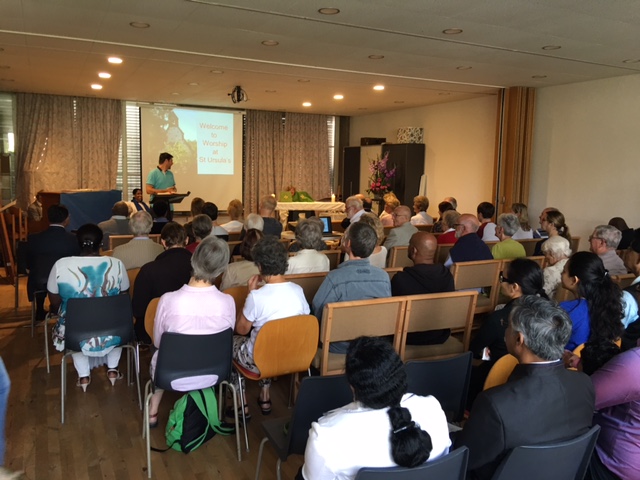 Today we held our service in the church hall, and we shall be doing so for the next five or six weeks, while the builders are in occupation of the church.
This will save time and money, as the church will not need to be reinstated every weekend.
In any case, the building work will generate a lot of dust, and keeping the congregation away from the work on the walls would have been impractical.
Today we held our service in the church hall, and we shall be doing so for the next five or six weeks, while the builders are in occupation of the church.
This will save time and money, as the church will not need to be reinstated every weekend.
In any case, the building work will generate a lot of dust, and keeping the congregation away from the work on the walls would have been impractical.
Stephen is away on a family holiday, and so the Sunday service was led by the Revd Elizabeth Bussmann, our diocesan environmental officer. Elizabeth and her husband Edi live in Aeschi. She normally leads services in Château d'Œx. Our lay reader, Archana Jacob, preached. Hans-Karl Pfyffer, our organist, proved up to the challenge of accompanying the liturgy on the piano.
After the rush of setting the space up, there were very few other hiccups. Several members of the congregation commented favourably, and gave helpful advice on small improvements we could make. The input we gathered will allow us to plan for a series of problem-free services in future weeks.
 Preparatory work has now started on the church.
Preparatory work has now started on the church.
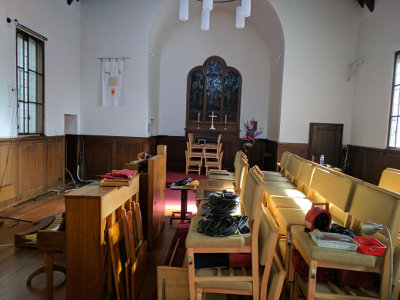 The area around the wall panelling has been cleared, and the conduits for the electrical cabling removed.
The area around the wall panelling has been cleared, and the conduits for the electrical cabling removed.
The new heating sytem will be installed against the walls, and is designed to throw heat into the main body of the church, with as little as possible going to waste. After these radiating panels have been installed, the panelling will be replaced with something very similar, with better thermal characteristics.
This should ensure a warm church, with a much reduced heating bill!
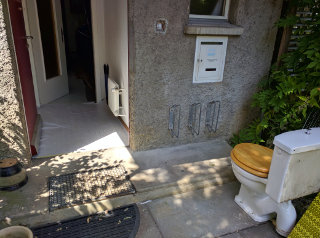 The builders' presence is making itself felt.
The builders' presence is making itself felt.
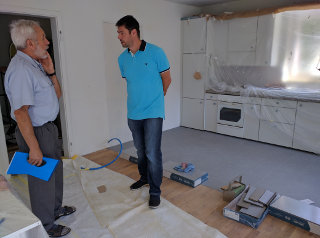 The wall dividing the kitchen and the dining area has been removed, making a more specious area for the chaplain, family and visitors.
While this is not part of the energy project, it has had to be scheduled to dovetail with the energy work.
The wall dividing the kitchen and the dining area has been removed, making a more specious area for the chaplain, family and visitors.
While this is not part of the energy project, it has had to be scheduled to dovetail with the energy work.
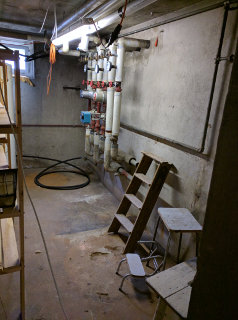 The old oil tank and boiler have been removed.
The new heating system will be gas-based, for ease of maintenance, and the boiler will be smaller, since a more efficient heating system and more effective insulation mean that we need fewer kilowatts of heat from it.
The former tank room will be used as the house cellar, and the former Schutzraum (bomb shelter) made accessible from the lower church hall.
The old oil tank and boiler have been removed.
The new heating system will be gas-based, for ease of maintenance, and the boiler will be smaller, since a more efficient heating system and more effective insulation mean that we need fewer kilowatts of heat from it.
The former tank room will be used as the house cellar, and the former Schutzraum (bomb shelter) made accessible from the lower church hall.
We have at last reached agreement with the conservation authorities (Denkmalschutz) on the form of heating we will be using in the church. This will rely on efficient radiators in the walls (a technique used in several churches). The panelling will have to be removed and modified. This will mean the church will be out of use for four to six weeks from 20 August, and we shall be holding services in the hall.
There is work to be done in the hall, too, which can be done relatively quickly in a short "window of opportunity" just after the autumn book and food sale.
The last phase of the project involves insulation work on the church house, which will take place in September.
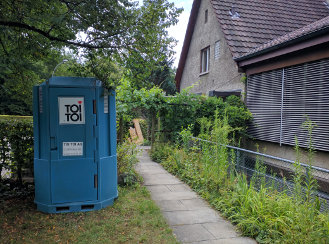 Work has started, and it's all happening at once.
Stephen and Jane have been on holiday for part of the last few weeks, and we have taken the opportunity of doing some vital maintenance work on the house - relaying the downstairs floors, taking out the old shelving in the study, and, most noticeably, taking down the wall dividing the kitchen from the dining area, so that the downstairs is open plan, well-lit and comfortably spacious.
Work has started, and it's all happening at once.
Stephen and Jane have been on holiday for part of the last few weeks, and we have taken the opportunity of doing some vital maintenance work on the house - relaying the downstairs floors, taking out the old shelving in the study, and, most noticeably, taking down the wall dividing the kitchen from the dining area, so that the downstairs is open plan, well-lit and comfortably spacious.
At the same time, we are replacing the old oil-fired boiler with a more silent gas-powered heating system, dimensioned to our reduced energy needs. The insulation work, when complete, will mean we use far less fuel, and the new boiler will mean that we are not burning our money needlessly. It will benefit the environment too.
A doorway between the lower hall and the house cellar will mean that we have better access to the heating infrastructure - it also opens a useful storage area, which we hope will not get filled up with junk!
The next sub-projects are due to start in August. We'll keep you informed about them when they happen!
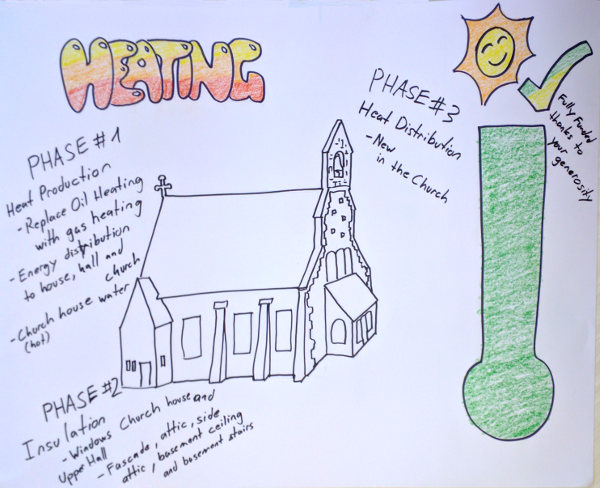 The good news is that planning permission has now come through, and we can get started on the work.
A lot of the first stage of the work involves the church house, and we are taking advantage of the holiday season do some other essential work on the interior layout to bring its standard up to the 21st century.
The good news is that planning permission has now come through, and we can get started on the work.
A lot of the first stage of the work involves the church house, and we are taking advantage of the holiday season do some other essential work on the interior layout to bring its standard up to the 21st century.
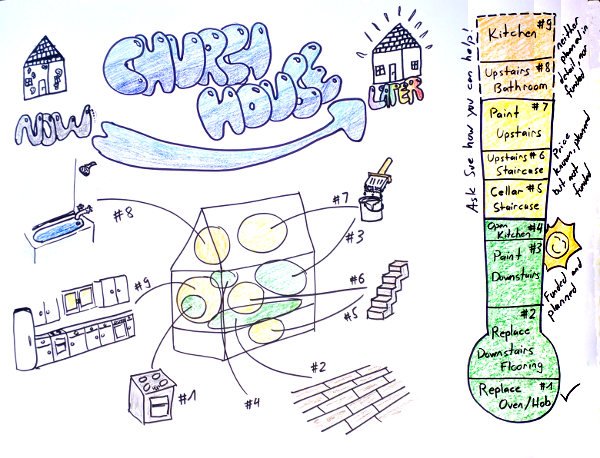 The work on the inside of the house involves replacing the oven and hob, laying a raised wooden floor in the office, living and dining area, and a vinyl floor in the kitchen, repapering or painting the walls, doors, radiators and ceilings, and remodelling the wall between the kitchen and dining area.
None of these is part of the energy project itself, and it is being funded from a separate budget for house renewals and repairs.
Contributions towards the cost are, however, very welcome!
The work on the inside of the house involves replacing the oven and hob, laying a raised wooden floor in the office, living and dining area, and a vinyl floor in the kitchen, repapering or painting the walls, doors, radiators and ceilings, and remodelling the wall between the kitchen and dining area.
None of these is part of the energy project itself, and it is being funded from a separate budget for house renewals and repairs.
Contributions towards the cost are, however, very welcome!
Another piece of work related to, but not part of the energy project, is making an entrance to the church house cellar from the lower hall. This will allow easy access to the heating system (which heats the house, the hall and the church) without disturbing the chaplain's family. We hope it will also allow us to make more sensible use of our storage space, which has grown rather out of hand!
A last drive for funding has begun. We are fortunate that His Excellency Mr David Moran, the British Ambassador, has agreed to host a fund-raising event in August at the Residence which will allow us to appeal for that extra cushion that means our finances remain secure.
A very successful and well-attended Ethiopian evening raised some Fr2000 towards our appeal. Many thanks to our sisters and brothers in the Ethiopian church for their help and hospitality!
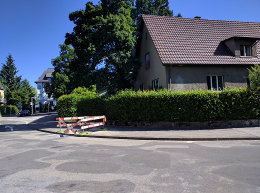 The application for building permission is now being processed by the city authorities.
As expected, we found that the wooden panelling in the church had been part of the original design - the wall behind it was completely unplastered brickwork.
This meant that we have had to think again about the church heating, perhaps with an underfloor solution.
Once building permission for the house and hall has been received, we can start work.
Contracts have been signed, and work can start as soon as permission comes through.
The application for building permission is now being processed by the city authorities.
As expected, we found that the wooden panelling in the church had been part of the original design - the wall behind it was completely unplastered brickwork.
This meant that we have had to think again about the church heating, perhaps with an underfloor solution.
Once building permission for the house and hall has been received, we can start work.
Contracts have been signed, and work can start as soon as permission comes through.
The observant will have noticed a hole in the pavement outside the church house. EWB have been installing gas to the building, as we shall be using less energy, and one part of the project involves replacing our bulky and noisy boiler with a smaller, more silent and more efficient model. Watch out for more signs of progress!
The firms we are inviting to tender for the work came to view the site on Maundy Thursday, and we will receive their tenders before the end of the month.
Last week, some of our team went to Zollikofen with representatives of H+K Planung to inspect the heating in the parish church. This basically consists of a heated wall. The sacristan there told us that this had dramatically improved the church heating, and lowered the costs. H+K have also delivered a similar project at Gretzenbach (SO).
One problem with such a solution is that it will work best if the wooden panels in the nave are removed. People have commented that these panels make the church look darker and less inviting, but the Denkmalschutz need to be convinced that they are not an original feature of the building. We will remove a part of the panelling and see if the wall behind is plastered, which will be a sign that the woodwork is not original.
HD - Page last modified 17 September 2018
| Social Media | Worship | About Us | Things we do | Administration | External Links |
| Services | News | Library | Finance | Diocese in Europe | |
| Rotas | Who are we? | Magazine | Budget | Swiss Archdeaconry | |
| Notice sheet | Contact People | Charities | AGM Reports | Other Churches in Berne | |
| Sunday readings | Pastoral care | Sales and Bazaars | Forms | Some useful links | |
| Sermons | Where We Are | Baptisms | Constitution | ||
| Photo Tour | Today's Morning and Evening Prayer | History | Weddings | Miscellaneous | |
| Site map | Thun | ||||
| Home | Junior Church | Mail us | |||
| Safeguarding |